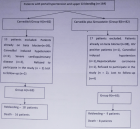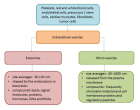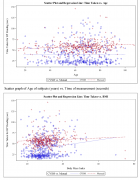Abstract
Short Communication
HBV: Genomic Structure, HBVsAg Isolation and innovative Virotherapy Initiation in the Middle East
Aboul-Ata E Aboul-Ata*, Essam M Janahi, I M El-Kalamawy, Kathleen Hefferon and Amal Mahmoud
Published: 09 August, 2017 | Volume 1 - Issue 2 | Pages: 059-061
Hepatitis B virus (HBV) is one of the world’s major infectious diseases with 350 million people who are chronic carriers of HBV [1]. Significant minorities go on to develop liver cirrhosis or hepatocellular carcinoma and over 1 million die annually from HBV-diseased liver. Janahi E. at faculty of science, Bahrain University, Bahrain has submitted the following information [2], on HBV-genome organization as part of his Ph.D. degree (2007) in Imperial College, England. HBV genomic organization has 4 Open Reading Frames (ORFs) i.e. Pre-S/S Gene, Pre-C/C ORF, P ORF and X ORF. Regulatory Elements has 4 promoters (pre S2, pre S1, C promoters and X promoters), Pregenomic RNA, Enhancers (Enh 1 and Enh 2) where they are involved in cccDNA formation, Glococorticoid-Responsive Element which is located in X ORF and P ORF overlapping, Polyadenylation Signal (Direct Repeat 1 (DR1) and Direct Repeat 2 (DR2)), Epsilon-Stem Loop and Post-Transcriptional Regulatory Element. HBV genotype D is prevalent in our Middle East area. The HBV genome is a partially relaxed-circular dsDNA molecule consisting of a full length strand (minus strand) with a single unique nick and a complementary (positive strand) of variable length. HBV is considered as a para-retrovirus because its replication involves the reverse transcription of an intermediate-RNA function, of pre-genomic RNA (pgRNA). Replication of HBV genome starts with the encapsidation of the pgRNA and encodes HBV polymerase into an immature nucleocapsid formed by the viral core antigen.
Read Full Article HTML DOI: 10.29328/journal.jpsp.1001007 Cite this Article Read Full Article PDF
References
- Aboul-Ata E Aboul-Ata, Antonella Vitti, Maria Nuzzaci, Ahmad K. El-Attar, Giuseppina 779 Piazzolla‡, et al. Plant-Based Vaccines: Novel and Low-CostPossible Route. For Mediterranean Innovative Vaccination Strategies. Advances in Virus Research. 2014; 89: 1-35.
- Janahi EM, Hepatitis B virus. thesis. Imperial Collage of Science. 2007.
- Elghannam MS, Attia AS, Shoeb HA, Hashem AM. Expression and purification of hepatitis B surface antigen S from Escherichia coli; a new simple method. BMC Res Notes. 2012; 5: 125-134. Ref.: https://goo.gl/Wj2VX2
- El Kalamawy IM, El haddad S, Swelim MA, Hamdy SM, Hanan Molecular variability of S gene of Hepatitis B Virus in Egypt. International J of Virology. 2011; 7: 109-115.
- Mahmoud Amal, Hashem MH. Bioinformatics analysis of polymerase and envelope genes of hepatitis B virus in Egypt. Egyptian J Virol. 2014; 11: 32-37. Ref.: https://goo.gl/b23S4b
- Hefferon Kathleen. DNA virus Vectors for Vaccine Production in Plants: Spotlight on Geminiviruses. Vaccines (Basel). 2014; 2: 642-653. Ref.: https://goo.gl/xUzkT2
- Huang Z, Chen Q, Hjelm B, Arntzen C, Mason H. A DNA replicon system for rapid high-level production of virus-like particles in plants. Biotechnol Bioeng. 2009; 103: 706-714. Ref.: https://goo.gl/sb1JTx
- Pniewski T, Kapusta J, Bocia˛g P, Wojciechowicz J, Kostrzak A, et al. Low-dose oral immunization with lyophilized tissue of herbicide-resistant lettuce expressing hepatitis B surface antigen for prototype plant-derived vaccine tablets formulation. J Appl Genet. 2011; 52: 125-136. Ref.: https://goo.gl/pmHbwA
- Pniewski T, Kapusta J, Bociag P, Kostrzak A, Fedorowicz-Strońska O, et al. Plant expression, lyophilisation and storage of HBV medium and large surface antigens for a prototype oral vaccine formulation. Plant Cell Rep. 2012; 31: 585-595. Ref.: https://goo.gl/WxUgx2
Figures:

Figure 1

Figure 2
Similar Articles
-
Impact of Calcium Phosphate Nanoparticles on Rice PlantHrishikesh Upadhyaya*,Lutfa Begum,Bishal Dey,P K Nath,S K Panda. Impact of Calcium Phosphate Nanoparticles on Rice Plant. . 2017 doi: 10.29328/journal.jpsp.1001001; 1: 001-010
-
The Effects of Pharmacological Carbonic Anhydrase Suppression on Defence Responses of Potato Leaves To Phytophthora InfestansMagdalena Arasimowicz-Jelonek*,Jolanta Floryszak-Wieczorek. The Effects of Pharmacological Carbonic Anhydrase Suppression on Defence Responses of Potato Leaves To Phytophthora Infestans. . 2017 doi: 10.29328/journal.jpsp.1001002; 1: 011-025
-
Phytochemical content of leaf and stem of Marsilea quadrifolia (L.)Rajangam Udayakumar*,Karikalan Gopalakrishnan. Phytochemical content of leaf and stem of Marsilea quadrifolia (L.). . 2017 doi: 10.29328/journal.jpsp.1001003; 1: 026-037
-
Antagonistic features displayed by Plant Growth Promoting Rhizobacteria (PGPR): A ReviewMohsin Tariq*,Muhammad Noman,Temoor Ahmed,Amir Hameed,Natasha Manzoor,Marriam Zafar. Antagonistic features displayed by Plant Growth Promoting Rhizobacteria (PGPR): A Review . . 2017 doi: 10.29328/journal.jpsp.1001004; 1: 038-043
-
Wild-type Agrobacterium rhizogenes-mediated gene transfer in plants: Agrobacterium virulence and selection of transformantsShu Wei*,Muhammad Abdullah,Ferdinand L Shamalla,Mohammad M Rana. Wild-type Agrobacterium rhizogenes-mediated gene transfer in plants: Agrobacterium virulence and selection of transformants. . 2017 doi: 10.29328/journal.jpsp.1001005; 1: 044-051
-
Effects of Vochysia haenkeana extract on the neuromuscular blockade induced by Bothrops jararaca venom on chick biventer cervicis preparation in vitroYoko Oshima-Franco*,Fernanda Dias da Silva,Natália Tribuiani,Isadora Caruso Fontana Oliveira,Regina Yuri Hashimoto Miura,Rafael S Floriano,Márcio Galdino dos Santos,Sandro Rostelato-Ferreira. Effects of Vochysia haenkeana extract on the neuromuscular blockade induced by Bothrops jararaca venom on chick biventer cervicis preparation in vitro. . 2017 doi: 10.29328/journal.jpsp.1001006; 1: 052-058
-
HBV: Genomic Structure, HBVsAg Isolation and innovative Virotherapy Initiation in the Middle EastAboul-Ata E Aboul-Ata*,Essam M Janahi,I M El-Kalamawy,Kathleen Hefferon,Amal Mahmoud. HBV: Genomic Structure, HBVsAg Isolation and innovative Virotherapy Initiation in the Middle East . . 2017 doi: 10.29328/journal.jpsp.1001007; 1: 059-061
-
Physiological impact of Zinc nanoparticle on germination of rice (Oryza sativa L) seedUpadhyaya H*,Roy H,Shome S,Tewari S,Bhattacharya MK,Panda SK. Physiological impact of Zinc nanoparticle on germination of rice (Oryza sativa L) seed . . 2017 doi: 10.29328/journal.jpsp.1001008; 1: 062-070
-
Effects of Site Factors on the Clonal Growth of Phyllostachys bambusoides f. shouzhu YiXiaohong Gan*,Lijuan Chen,Cuibin Tang,Xia Zhang. Effects of Site Factors on the Clonal Growth of Phyllostachys bambusoides f. shouzhu Yi. . 2017 doi: 10.29328/journal.jpsp.1001009; 1: 071-079
-
Evaluation of genetic diversity in germplasm of paprika (Capsicum spp.) using random amplified polymorphic DNA (RAPD) markersRueda-Puente EO*,Renganathan P,Ruíz-Alvarado C,Hernández-Montiel LG,Prasath Duraisamy. Evaluation of genetic diversity in germplasm of paprika (Capsicum spp.) using random amplified polymorphic DNA (RAPD) markers. . 2017 doi: 10.29328/journal.jpsp.1001010; 1: 080-086
Recently Viewed
-
Overview on liquid chromatography and its greener chemistry applicationAdel E Ibrahim,Magda Elhenawee,Hanaa Saleh,Mahmoud M Sebaiy*. Overview on liquid chromatography and its greener chemistry application. Ann Adv Chem. 2021: doi: 10.29328/journal.aac.1001023; 5: 004-012
-
COPD and low plasma vitamin D levels: Correlation or causality?Luca Gallelli*, Erika Cione,Stefania Zampogna, Gino Scalone. COPD and low plasma vitamin D levels: Correlation or causality? . J Pulmonol Respir Res. 2018: doi: 10.29328/journal.jprr.1001008; 2: 011-012
-
Environmental Factors Affecting the Concentration of DNA in Blood and Saliva Stains: A ReviewDivya Khorwal*, GK Mathur, Umema Ahmed, SS Daga. Environmental Factors Affecting the Concentration of DNA in Blood and Saliva Stains: A Review. J Forensic Sci Res. 2024: doi: 10.29328/journal.jfsr.1001057; 8: 009-015
-
Markov Chains of Molecular Processes of Biochemical MaterialsOrchidea Maria Lecian*. Markov Chains of Molecular Processes of Biochemical Materials. Int J Phys Res Appl. 2024: doi: 10.29328/journal.ijpra.1001076; 7: 001-005
-
Generation of Curved Spacetime in Quantum FieldSarfraj Khan*. Generation of Curved Spacetime in Quantum Field. Int J Phys Res Appl. 2024: doi: 10.29328/journal.ijpra.1001077; 7: 006-009
Most Viewed
-
Evaluation of Biostimulants Based on Recovered Protein Hydrolysates from Animal By-products as Plant Growth EnhancersH Pérez-Aguilar*, M Lacruz-Asaro, F Arán-Ais. Evaluation of Biostimulants Based on Recovered Protein Hydrolysates from Animal By-products as Plant Growth Enhancers. J Plant Sci Phytopathol. 2023 doi: 10.29328/journal.jpsp.1001104; 7: 042-047
-
Sinonasal Myxoma Extending into the Orbit in a 4-Year Old: A Case PresentationJulian A Purrinos*, Ramzi Younis. Sinonasal Myxoma Extending into the Orbit in a 4-Year Old: A Case Presentation. Arch Case Rep. 2024 doi: 10.29328/journal.acr.1001099; 8: 075-077
-
Feasibility study of magnetic sensing for detecting single-neuron action potentialsDenis Tonini,Kai Wu,Renata Saha,Jian-Ping Wang*. Feasibility study of magnetic sensing for detecting single-neuron action potentials. Ann Biomed Sci Eng. 2022 doi: 10.29328/journal.abse.1001018; 6: 019-029
-
Pediatric Dysgerminoma: Unveiling a Rare Ovarian TumorFaten Limaiem*, Khalil Saffar, Ahmed Halouani. Pediatric Dysgerminoma: Unveiling a Rare Ovarian Tumor. Arch Case Rep. 2024 doi: 10.29328/journal.acr.1001087; 8: 010-013
-
Physical activity can change the physiological and psychological circumstances during COVID-19 pandemic: A narrative reviewKhashayar Maroufi*. Physical activity can change the physiological and psychological circumstances during COVID-19 pandemic: A narrative review. J Sports Med Ther. 2021 doi: 10.29328/journal.jsmt.1001051; 6: 001-007

HSPI: We're glad you're here. Please click "create a new Query" if you are a new visitor to our website and need further information from us.
If you are already a member of our network and need to keep track of any developments regarding a question you have already submitted, click "take me to my Query."

















































































































































